An Economic Comparison of Three Cell Culture Techniques
Comparing the economic feasibility of a typical glycosylated protein.
ABSTRACT
Fed-batch and perfusion culture are the two dominant modes of operation for mammalian-cell-culture based processes, especially for the production of glycosylated proteins required in large amounts. This article provides an economic comparison for the production of a typical glycosylated protein using the fed-batch, concentrated fed-batch (CFB), and concentrated perfusion (CP) technologies. The CFB and CP processes are based on the ATF System, a platform technology developed by Refine Technology for biologics production.
The market for protein-derived products has grown significantly in the past decade and continues to accelerate at a rapid rate. As more recombinant therapeutic proteins enter development and get through the approval phase, more efficient large-scale production of such proteins is necessary to meet the surging demand. Fed-batch and perfusion culture are the two dominant modes of operation for mammalian-cell-culture based processes, especially for the production of glycosylated proteins required in large amounts.1 Challenges in the industry (such as competitive products for the same indication or desired cost reductions) are forcing many to explore new production options.
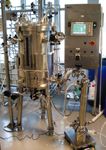
(REFINE TECHNOLOGY)
In fed-batch culture, there is a gradual addition of a fresh volume of selected nutrients during the growth–culture cycle to improve productivity and growth. The culture is subsequently harvested and the product recovered. Fed-batch culture has been an attractive choice for large-scale production due to its operational simplicity and familiarity as a carryover process from fermentation. However, fed-batch mode of operation typically also involves high start-up costs, resulting from the need for larger bioreactor plant capacity.
In perfusion culture, a continuous supply of fresh media is fed into the bioreactor while growth-inhibitory by-products are constantly removed. The increasing interest in the use of perfusion culture can be attributed to the higher product output from a reduced reactor size (hence, simplifying operation, cleaning, and sterilization). The cell densities achieved in perfusion culture (30–100 x 106 cells/mL) are typically higher than for fed-batch modes (5–25 x 106 cells/mL).2 The principal aspect of perfusion operation, which is different from fed-batch, is the added requirement of a cell-retention device. Cell-retention systems add a level of complexity to the process, requiring management, control, and maintenance for successful operation. Perfusion bioreactors can suffer operational difficulties such as malfunction or failure of the cell-separation device, which can lead to shortening of the production run, leading further, to increased operating costs. This has previously limited their attractiveness.
In recent years, a platform technology has been developed for biologics production—the ATF System, introduced by Refine Technology (Pine Brook, NJ). Used in the alternating tangential flow mode, it is a low shear filtration system that inhibits filter-membrane fouling. This external cell-separation system is able to maintain continuous culture for extended periods of time and offers the capability of rapid filter change without compromising the culture run.3 The ATF System allows increased volumetric productivity and reduced bioreactor size.
Concentrated fed-batch and concentrated perfusion are two production techniques based on the ATF System, which simultaneously nourishes the culture and concentrates the product within the bioreactor. These manufacturing methods permit great increases in cell and product concentrations as compared with fed-batch and perfusion. For example, in the concentrated fed-batch production platform, one of Refine Technology's pharmaceutical clients has reported a protein product titer of 17 g/L with an unoptimized Chinese hamster ovary (CHO) cell process.4 Higher titers are expected as process optimization continues. In the concentrated fed-batch operation, ultra-high cell densities of (70–200) x 106 cells/mL have been achieved; similarly, extremely high cell densities in the region of (70–100) x 106 cells/mL have been achieved in systems using the concentrated perfusion mode.
The system scales on a linear basis from 1 L to greater than 1,000 L and can be used with traditional or disposable bioreactors and with all cell types including anchorage-dependent lines. Table 1 indicates the working volume sizes for each ATF System in the scale-up process. The figures in the table are provided as guidelines. Actual capacity and vessel size depend on process conditions.

Table 1. Guideline working volume sizes for each ATF system
This article compares the economic feasibility of a typical glycosylated protein manufactured using three production techniques—fed-batch (FB), concentrated fed-batch (CFB), and concentrated perfusion (CP). The Excel-based process-cost modeling tool, BioSolve from BioPharm Services (Chesham, Buckinghamshire, UK), was used for the economic assessment. The methodology, assumptions, and key results of the cost model are described. The analysis will use the cost of goods (CoG) metric expressed on a per gram basis for comparability.
EVALUATION METHODOLOGY
The commercial process-cost modeling software, BioSolve, is used to assess the process economics of the FB, CFB, and CP production techniques. The CoG is a useful metric to quantify the operating costs of a manufacturing option. BioSolve is an Excel-based tool that determines the CoG by accounting for the indirect (fixed) overheads of the facility and the direct (variable) operating costs of the process. The fixed-cost element consists of capital charges, taxes, and insurance, and direct costs include consumables, materials, labor, and waste management. Such an approach to estimate the CoG has been used to evaluate the process economics of disposable membrane chromatography for use in biomanufacturing.4,5
Figure 1 illustrates the basic BioSolve framework, which comprises the user interface, process definition, productivity and cost calculations, and model outputs. The interface allows a rapid assessment of the impact of predefined key input parameters (e.g., process scale, product titer, disposable options) on the model outputs. The core of the cost model consists of the process definition, which includes the mass balances, equipment sizing, operating parameters, and resource allocation. The calculated items include plant productivity, labor requirements, consumable and materials usage, and equipment list. The costs of these components are maintained in a cost database, which is built with data consisting of benchmarking information from several biomanufacturing operations. The key outputs generated by the cost model are facility throughput, bill of materials, CoG, and capital investment.
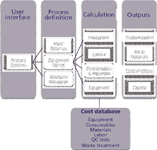
Figure 1. Framework of BioSolve
CASE STUDY BACKGROUND
The model compares the manufacture of a glycosylated protein in three different production techniques—FB, CFB, and CP. Figure 2 depicts the process sequences for these production methods. The seed train for the FB process is longer because this option requires more steps to scale-up to the production cell culture bioreactor. The FB upstream process information was derived from commercially relevant operations commonly practiced in the industry. The upstream information for the CFB and CP processes was provided by Refine Technology, based on data supplied by its clients. In the FB and CFB processes, the removal of cells is achieved by centrifugation and depth filtration. Such recovery-unit operations are not required in the CP process because the cells are retained in the ATF System. The three processes were assumed to have the same purification sequence. This downstream sequence was selected according to commercial relevance and sourced from details that are available in the public domain. Table 2 summarizes the key operating parameters used in the base case study.
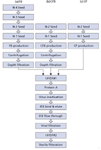
Figure 2. Process sequence (a) fed-batch (FB), (b) concentrated fed-batch (CFB), and (c) concentrated perfusion (CP) for the production of a glycosylated protein
For the FB process, all the seed steps included in the model are assumed to be batch fermentations. In the production cell culture step, two additional feeds are added to the bioreactor three days and six days after inoculation. The final growth phase takes about 13 days.
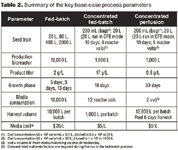
Table 2. Summary of the key base-case process parameters
The CFB and CP seed sequence is performed using a 200 mL bag carried out in batch fermentation mode, followed by a 20 L bioreactor also run in the CFB mode.
In the FB and CFB processes, the recovery procedure is centrifugation followed by depth filtration. An ultrafiltration/diafiltration (UF/DF) step is used to concentrate the product stream before the Protein A unit operation. A virus inactivation step occurs. The product stream is subsequently loaded onto an ion exchange (IEX) bind and elute column and passed through an IEX flow-through column. A viral filtration step takes place before the UF/DF step. A final sterile filtration step is used to purify the product. This purification sequence is based on typical unit operations for the production of a glycosylated protein, using typical solutions and timings. The overall yield for the downstream sequence is 50% and 69% for the FB/CFB and CP processes, respectively.
COST MODEL RESULTS
Scenario 1: Base Case
The analysis in this scenario evaluates the process economics of the three production techniques using the assumptions stated in the previous section. Figure 3 shows the total CoG per gram broken down into fixed capital charges and variable costs such as materials, consumables, labor, and others (e.g., insurance, maintenance). As expected, the FB process has a higher upfront capital burden ($53 million) due to the need for a longer seed fermentation train and larger overall fermentation volume. The CFB and CP options benefit from increased throughput and reduced overall bioreactor capacity, which translates to lower initial investment costs. The CFB and CP technologies offer substantial capital charge reductions of 13% and 32%, respectively, relative to the FB process. The CoG per gram is inversely proportional to the annual product mass with the CP process producing the most product (265 kg/year) and FB producing the least amount of product (130 kg/year). This correlation between low CoG and high annual product mass is expected, because increased throughput of product will result in lower costs per gram produced.
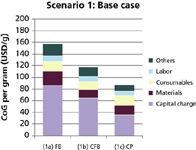
Figure 3: Cost of goods (CoG) results for the base case. FB: fed-batch; CFB: concentrated fed-batch; CP: concentrated perfusion.
In the CP process, the materials costs contribute a significant amount to the CoG. This can be attributed to the intensive usage of media over the extended perfusion culture cycle.
The model results indicate that the CP process (scenario 1c) is the most cost-effective technology with the lowest overall CoG per gram of $87/g. The CFB process (scenario 1b) is slightly more expensive at $118/g. The FB process (scenario 1a) has the highest CoG ($158/g). The CFB and CP options provide cost savings of about 25% and 45%, respectively, when compared to the FB process.
Scenario 2: Changing the Titer for the CFB Process
The expression levels in the CFB process can vary depending on the type of cell line and duration of cell-line development. In this section, the effect of changing the product titer for the CFB process is examined while keeping the bioreactor size constant at 1,000 L (Figure 4). In the worst-case scenario, the titer is reduced from 17 g/L (scenario 1b) to 10 g/L (scenario 2a). In the best-case scenario, the titer is increased to 25 g/L (scenario 2b).
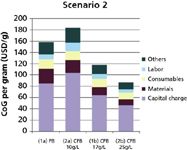
Figure 4. Cost of goods (CoG) results for the fed-batch (FB) process and the concentrated fed-batch (CFB) process at 10 g/L, 17 g/L, and 25 g/L (1,000 L bioreactor scale)
Reducing the titer, as expected, increases the CoG as the annual throughput is reduced. When the titer is reduced to 10 g/L (scenario 2a), the CFB process appears less economical as the CoG ($184/g) is higher than the FB CoG at $158/g (scenario 1a), as shown in Figure 4. On the other hand, when the titer is increased to 25 g/L, the CoG reduces to $87/g. This improvement in the expression level would make the CFB process much more attractive than the FB process with significant cost savings of 45%.
Scenario 3: Changing the Bioreactor Size for the CP Process
The bioreactor size used for running perfusion culture mode can vary. This section looks at changing the bioreactor size of the CP process while keeping the titer unchanged at 0.8 g/L. Two other bioreactor sizes (500 L and 750 L) are considered in this analysis. When the bioreactor volume is reduced to 500 L (scenario 3a in Figure 5), the CP process generates about the same annual output (132 kg) as the FB process (130 kg). The CoG of the CP process increases from the base figure of $87/g (scenario 1c) to $133/g (scenario 3a). The CP process at 500 L and 0.8 g/L is still more economical than the FB process. It should be noted that the simplification of material and people flow provided by reduced bioreactor capacity in the CP facility cannot be calculated easily but may provide the key driver to such technology being increasingly used in biomanufacturing.
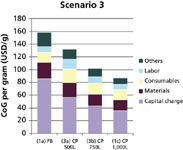
Figure 5. Cost of goods (CoG) results for the fed-batch (FB) process and the concentrated fed-batch (CFB) process using 500 L, 750 L, and 1,000 L (0.8 g/L titer)
CONCLUSIONS
This article has provided an economic comparison for the production of a typical glycosylated protein using the FB, CFB, and CBP technologies. The CFB and CP processes are based on the ATF System. The model results revealed that in the base case, CoG savings of 25% and 45% can be achieved using the CFB (1000 L, 17 g/L) and CP (1000 L, 0.8 g/L) technologies, respectively, when compared with the FB process (10,000 L, 2 g/L). The bulk of the savings is derived from the reduction in capital requirements due to higher productivities, resulting in reduced overall bioreactor capacity in these processes. The use of the CFB and CP technologies would seem a potential approach toward lower upfront capital investment and operating costs. Sensitivity analyses were performed on the product titer in the CFB process and the bioreactor volume in the CP process. The feasibility of the CFB technology reduces at the worst-case product titer (10 g/L) reported in current industrial processes. The CP CoG is still lower than the FB CoG when the bioreactor volume is reduced to 500 L.
In addition to cost considerations, there are other key factors that may affect the selection of an appropriate process for a drug candidate. The existing fed-batch and perfusion processes are well-known but both have limitations. The CFB mode with the ATF System is recommended if the product of interest is a single concentrated product stream harvested from the reactor. The CP mode can be used to reduce the size of bioreactor required to produce the same amount of product as in fed-batch or perfusion.
This article has not evaluated the use of the ATF System during the cell banking and seed expansion stages in the upstream manufacturing process.6 Performing perfusion cultures with such a system can generate large cell mass for high density freezing to be used for cell-banks preparation. High cell density freezing reduces the inoculum expansion time by removing the first seed passages and inoculates a small bioreactor directly from the freezer. This leads to reduced manual handling of culture and improved facility use.
The impact of the use of disposable bioreactors in the cell-culture operations has not been captured in this article analysis. Disposable systems are easier to set up and they eliminate cleaning requirements; hence the turnaround time for such single-use technologies is typically shorter compared with their stainless-steel counterparts. The faster turnaround time could result in increased plant throughput and affect the production costs of the facility.
Janice Lim is a bioprocess consultant and Andrew Sinclair is managing director, both at Biopharm Services, Chesham, UK. Jerry Shevitz is president and John Bonham Carter is vice-president of sales and business development, both at Refine Technology, Pine Brook, NJ, 793.993.3003, jbonhamcarter@refinetech.com.
REFERENCES
1. Chu L, Robinson DK. Industrial choices for protein production by large-scale cell culture. Curr Opin Biotechnol. 2001;12:180–187.
2. Carstens, Jason. Perfusion! Jeopardy or the Ultimate Advantage? BioProcess International webinar. 2009 Sept.
3. Furey J. Scale-up of a cell culture perfusion process. Gen Eng News. 2002;22:62.
4. Mora J, Sinclair A, Delmdahl N, Gottschalk U. Disposable membrane chromatography performance analysis and economic cost model. Bioprocess Int Suppl. 2006:4:38–43.
5. Lim JAC, Sinclair A, Kim DS, Gottschalk U. Economic benefits of single-use membrane chromatography in polishing—A cost of goods model. Bioprocess Int. 2007;5(2)48–56.
6. Noe W. Paradigm changes and technology gaps in the biopharmaceutical industry. BioProcess International Conference & Exhibition; 2009 October 12–15; Raleigh, NC, USA.
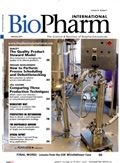
VERAXA and Voyager to Create Combined Business for Advancing Pipeline of Next-Gen Cancer Therapies
April 23rd 2025The proposed business combination would create a publicly traded, clinical-stage biopharmaceutical company that will focus on developing a pipeline of next-generation cancer therapies.
MHRA Approves GSK Therapy Combinations for Multiple Myeloma
April 21st 2025Belantamab mafodotin is approved in combination with bortezomib plus dexamethasone in patients who have had at least one prior therapy, and in combination with pomalidomide plus dexamethasone for those who have had a prior therapy including lenalidomide.
Tokyo University of Science Research Team Explores Improved Delivery of Antisense Oligonucleotides
April 18th 2025Using cholesterol-modified oligonucleotides, the research team aims to improve the delivery of antisense nucleotide-based therapies for treating neurodegenerative diseases and brain cancers.